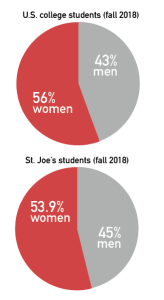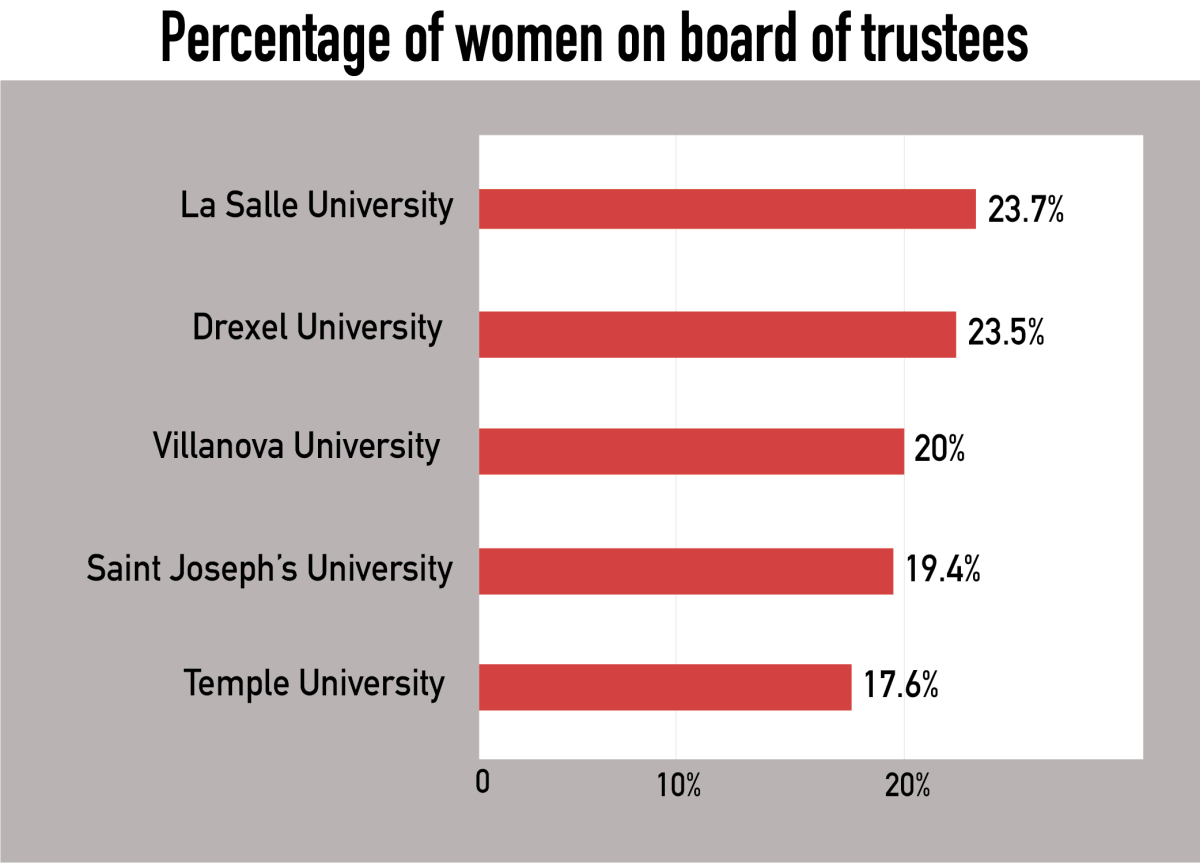A recent study conducted by the Women’s Nonprofit Leadership Initiative (WNLI) on the gender gap in boardrooms of higher education institutions in the Philadelphia area reported the St. Joe’s board of trustees is 19.4% women.
St. Joe’s ranked at 18 of the 25 colleges and universities mentioned in the study. The target percentage in the study was 30% women on the board.
The Nonprofit Center at La Salle University’s School of Business, in conjunction with the WNLI, an organization of female nonprofit leaders in the Philadelphia area, collected data on the gender and racial breakdown of governing boards at medical centers, colleges and universities in the Philadelphia area.
Carolyn Adams, Ph.D., former dean of the College of Liberal Arts at Temple University and member of the WNLI, said the purpose of the study is to highlight the lack of diversity in governing boards and encourage change.
“We are working with people in nonprofit institutions across the nation to not only help them increase the number of women that sit on their boards, but also to increase general awareness of this as an issue,” Adams said. “There’s so little understanding or even awareness of these governing boards of nonprofit institutions.”
Adams said it is important for students and faculty at a university to know who serves on their board because of the impact the board has on the campus community.
“Those decisions about what kind of climate we want on our campus, those ultimately are decisions and policies that are decided on by trustees,” Adams said. “These are all issues that really do affect the students’ experience.”
Laura Otten, Ph.D., executive director of the Nonprofit Center at La Salle University, said in order to fully ensure a positive student experience, the composition of the board should reflect the composition of the institution.
“There is a longstanding best practice in the nonprofit sector that says the boards of nonprofits should be reflective of the constituency they serve and the constituency they want to serve,” Otten said. “It’s really important that the boards of these institutions are diverse as well [as] reflective of the student bodies that they represent.”

The National Center for Education Statistics
Otten said having a diverse governing body improves the decision making capabilities of the board.
“Diversity of perspective, diversity of problem solving approaches, diversity of thinking patterns help a group make sure that it is achieving well thought out, well rounded decisions,” Otten said. “When a board is monolithic, it is depriving itself of these different perspectives that will help it make better, more well rounded decisions.”
Sarah Quinn ’89, MBA ’09, St. Joe’s chief of staff and liaison to the board of trustees, said diversity has been one of the board’s priorities for years. While other institutions give trustees three-year terms, according to Adams, Quinn said the governance and leadership committee, a subcommittee of the board of trustees, continuously reevaluates the needs of the board.
Quinn said while diversity has been a priority, there are other factors that play into who is selected to serve on the board.
“First and foremost, we look for people we know will be committed to the Jesuit and Catholic mission of the institution,” Quinn said. “Then we look for candidates who may have a specific skill set or knowledge that we feel might be good for the board based on the makeup of the other trustees at that time. One of the other things that’s important is that they’re willing to commit St. Joe’s as one of their top philanthropic interests.”
Jesuit representation also weighs heavily in the selection process, according to Gail Benner, public relations and media director at St. Joe’s.
“As a Jesuit institution, we want strong Jesuit representation, and so our numbers may never fully reflect that 50-50 percent exactly of our community, but valuing all kinds of diversity, thought and expertise and skill sets, and trying to make the most of that mix on the board is really what we’re after,” Benner said.
Although Quinn said they prioritize having Jesuit representation on the board, she added that there are practices in place to increase the role of women on the board, including having two women serving on the executive committee of the board, as well as women participating in
academic advisory boards.
Adams said this report should act as motivation for not only the board of trustees at universities, but for community members, especially at St. Joe’s, who can use their voices to influence their board.
“St. Joe’s has less than 20% women [on the board], so that’s not a very good representation,” Adams said. “Things need to improve there. It would be great if students or faculty or people who are interested in women’s studies could get really interested in this issue and raise it.”













































